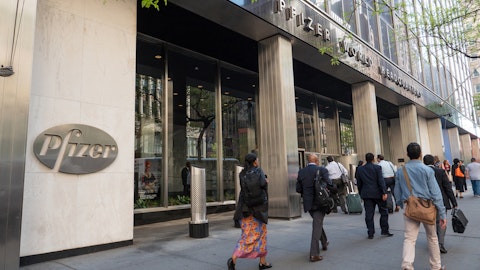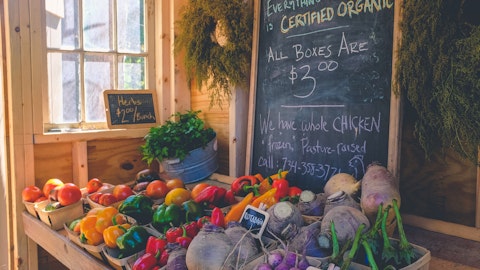Post Holdings, Inc. (NYSE:POST) Q4 2022 Earnings Call Transcript November 18, 2022
Post Holdings, Inc. beats earnings expectations. Reported EPS is $0.85, expectations were $0.7.
Operator: Good day and welcome to Post Holdings’ Fourth Quarter 2022 Earnings Conference Call and Webcast. Hosting the call today from Post are Rob Vitale, President and Chief Executive Officer; and Jeff Zadoks, Chief Financial Officer. Today’s call is being recorded and will be available for replay beginning at 12:00 p.m. Eastern Time. The dial-in number is 800-839-3742. No pass code is required. It is now my pleasure to turn the floor over to Jennifer Meyer, Investor Relations of Post Holdings for introductions. You may begin.
Jennifer Meyer: Good morning and thank you for joining us today for Post’s fourth quarter fiscal 2022 earnings call. With me today are Rob Vitale, our President and CEO; and Jeff Zadoks, our CFO. Rob and Jeff will begin with prepared remarks. And afterwards, we will have a brief question-and-answer session. The press release that supports these remarks is posted on our website in both the Investors and the SEC filings section at postholdings.com. In addition, the release is available on the SEC’s website. Before we continue, I would like to remind you that this call will contain forward-looking statements, which are subject to risks and uncertainties that should be carefully considered by investors as actual results could differ materially from these statements.

Copyright: evgenyatamanenko / 123RF Stock Photo
These forward-looking statements are current as of the date of this call, and management undertakes no obligation to update these statements. As a reminder, this call is being recorded and an audio replay will be available on our website. And finally, this call will discuss certain non-GAAP measures. For a reconciliation of these non-GAAP measures to the nearest GAAP measure, see our press release issued yesterday and posted on our website. With that, I will turn the call over to Rob.
Rob Vitale: Thanks, Jennifer and thank you all for joining us. Before commenting on our results, I want to congratulate both Jeff and Matt in connection with the announcement earlier this week. Jeff is ideal for this role, and that he has a deep knowledge of each business as well as the trust and the respect of each business leader. And Matt has been a key architect of many of Post sophisticated financial transactions. I look forward to working with them with each of them in their new roles. Post ended the year in strong fashion, anchored by exceptional performance in foodservice, we delivered a quarter with nearly $280 million in adjusted EBITDA, and a year with over $960 million in adjusted EBITDA. This represents a respective growth rate for the quarter and year of 32% and 8%.
Moreover, we look forward to delivering EBITDA growth rates above our historical norm through at least 2024. I would characterize 2022 as having been dominated by inflation management and ongoing supply chain challenges. We expect 2023 to be focused on margin restoration. I will comment more on that shortly. As I mentioned, foodservice had an exceptional quarter. I’m quite proud of the performance of this team having now entirely recovered from the depth of COVID, and added to the segment’s profitability. In addition to facing the global pandemic, we have navigated an avian influenza challenge and done so exceptionally well. For those of you who have been around a while, you may recall that this experience tends to make us a more effective competitor in a more profitable company.
That is not to see it comes without risk. There is always a risk that we may be impacted. Our Foodservice segment has been quite resilient now through different environments. We believe we are well positioned for a consumer pullback in that we skew to the less sensitive breakfast daypart. To date, we have seen no sign of a pullback from away-from-home consumption. Post Consumer Brands too had a solid quarter. Our branded consumption dollars grew to 19.4%. At the same time, we experienced a bit of a category trade down to value in private label, both of which are profit accretive. Key trends from the year continued in the quarter. We continue to be disciplined in price realization relative to inflation, and we continue to work our way back to pre-pandemic levels of supply chain execution.
Refrigerated Retail exited 2022 in a markedly improved manner over last year. Recall that last year, supply chain was inhibited our ability to build inventory for the all critical holiday season. This year, inventories are at a solid level and customer fill rates dramatically improved. High egg prices inhibited volume and profit in this segment, but on balance, it has made great progress. On a local currency basis, Weetabix continues its rock-solid performance. We continue to face headwinds in currency translation, and we expect ongoing pressure on our consumers and our cost structure. Last night, we provided guidance for 2023 of $990 million to $1,040 million of adjusted EBITDA. Even at this level of growth, we still have opportunity for earnings acceleration driven primarily by margin recovery.
Over the last 3 years, enterprise-wide EBITDA margins have decreased approximately 440 basis points. Roughly half of this decrease is attributable to growth in foodservice and attractive acquisitions that yield lower EBITDA margins. So mix related. The remaining half is our addressable opportunity. Attacking this opportunity will be a multiyear effort focused on several areas, including maintaining pricing discipline vis-Ã -vis input cost inflation, stabilization of supply chain costs and performance, better leverage on fixed assets within Refrigerated Retail, and improvements in manufacturing asset reliability aimed at minimizing plant downtime. We do expect to face some temporary margin pressure in the UK as energy prices remain at historically high levels.
Nonetheless, this bucket of margin opportunity is what affords us the confidence to reference above-average EBITDA growth over a multiyear trajectory. With respect to cadence, we anticipate a fairly even split of adjusted EBITDA between the first and second half with foodservice favoring the first half and retail channel business is favoring the second. As you know, we expect to monetize our remaining ownership in BellRing in the next several months. Net of our BellRing position, our leverage ratio was 5.4x and positions us for M&A. The market for M&A is interesting. The high-yield market is choppy and struggling to absorb some high-profile credits. Our August financing left us with a cash rich balance sheet. Post is an advantaged buyer in a challenging financing environment, and we welcome all opportunities.
In addition to M&A, we continue to see additional opportunities in our own securities. As appropriate, we will invest in our bonds, our equity, our internal operations, and in non-organic growth. We expect the capital expenditures in 2023 to yield attractive incremental EBITDA competitive with other forms of capital allocation. You all know in 2021, Post sponsored a novel Corporate-Own SPAC. We have until May to identify an attractive partner for a business combination. While we continue to believe this is an elegant tool for Corporate Finance, our timing was terrible. We continue to seek opportunities, but we will certainly not chase an opportunity simply to transact. We are perfectly comfortable acknowledging that some experiment sale. In closing, I want to thank everybody for a successful 2022 against a backdrop that ordered on chaotic.
We have had over 2 years of heightened uncertainty and my confidence level is higher than it has been since COVID began. With that, I will turn the call over to Jeff.
See also Top 15 Chinese Companies on NASDAQ and 10 Cheapest Stocks with Biggest Upside.
Jeff Zadoks: Thanks Rob and good morning everyone. Fourth quarter consolidated net sales were $1.6 billion and adjusted EBITDA was $280 million. Net sales increased 16.5%, and benefited from pricing actions in each segment and continued volume recovery in our foodservice business. Supply chain disruptions eased slightly, but our per unit product costs remained elevated and our customer order fulfillment rates remain below optimal levels. Turning to our segments and starting with Post Consumer Brands. Net sales and volumes increased 13% and 2%, respectively. Cereal average net pricing increased 10.5%, driven by pricing actions, partially offset by unfavorable product mix. Peter Pan, Pebbles, private label cereal and MOM bags drove the volume increase.
Declines in Honey Bunches of Oats partially offset these increases as we lap the change in the timing of a club promotion. Adjusted EBITDA increased 10% versus prior year as volume growth and our pricing actions outweighed significant cost inflation. Weetabix net sales decreased 8%. In local currency, however, sales were up approximately 8%, a significantly weaker British pound caused a foreign currency translation headwind of approximately 1,500 basis points. Net sales benefited from significant list price increases and sales from the recently acquired UFIT brand. These benefits were partially offset by unfavorable mix, reflecting growth in private label products. Excluding the benefit from UFIT, volumes declined 9% as growth in private label was not enough to offset declines in other products, which were largely driven by supply chain constraints and related shortfalls in order fulfillment.
Segment adjusted EBITDA was 13% lower than prior year, primarily because of the aforementioned foreign currency translation headwind. Unfavorable mix also weighed on profitability this quarter. Our foodservice business saw net sales and volume growth of 37% and 4%, respectively. Revenue growth continued to outpace volume growth as revenue reflects the impact of inflation-driven pricing actions, the effect of our commodity cost pass-through pricing model and avian influenza driven pricing actions to offset higher cost to procure eggs on the spot market. Segment adjusted EBITDA grew to $110 million, benefiting from improved average net pricing and volume growth, which combined mitigated the impact of higher cost to produce. Refrigerated Retail net sales decreased 1%, while volumes decreased 15%, excluding the divested Willamette Egg Farms business, net sales increased 3% and volumes declined 7%.
Pricing actions drove increases in average net pricing across all products. Side dish and sausage volumes were relatively flat, while volumes in egg and cheese products declined. In addition, elevated egg costs and limited cage-free egg availability from avian influenza hurt both volume and margins. Overall, segment volumes were pressured by changes in promotional timing when compared to the prior year and modest elasticities resulting from inflation-driven price increases. Segment adjusted EBITDA increased 49%, benefiting from pricing actions and favorable product mix. This was partially offset by higher dairy and egg costs and higher manufacturing costs. Turning to cash flow. We had a strong quarter, generating $165 million from continuing operations.
Improved profitability and working capital were the key drivers of this quarter’s improved performance. For the full year, cash flow from continuing operations was $384 million with $241 million coming from the in the second half of the year as our profitability improved sequentially throughout the year. Capital expenditures were $88 million in the fourth quarter and totaled $255 million for the year. As a reminder, annual maintenance CapEx is approximately $190 million to $200 million. This year’s elevated CapEx was primarily driven by construction costs related to our new RTD shake manufacturing facility for BellRing. As you saw in our guidance, we expect continued elevated capital expenditures in FY 2023, as we complete this project and make additional investments in equipment reliability and other profit-enhancing projects.
Moving to capital markets transactions. In the fourth quarter, we issued $575 million in principal value of 2.5% convertible senior notes that mature in 2027. We used $100 million of these proceeds to repurchase 1.1 million of our shares at a price of $90.30 per share. For the full year, we purchased 4.9 million of our shares. Subsequent to the end of the quarter, we purchased approximately 200,000 shares at an average price of $82.76 per share. We now have $283 million remaining under our share repurchase authorization. Our net leverage at the end of the fourth quarter, as measured by our credit facility that was approximately 5.6x. Net leverage decreased 0.6x versus the third quarter, reflecting both growth in adjusted EBITDA and a reduction in our debt resulting from the debt for equity exchange completed in August.
With that, I’d like to turn the call back to the operator to do Q&A.
Q&A Session
Follow Post Holdings Inc. (NYSE:POST)
Follow Post Holdings Inc. (NYSE:POST)
Operator: Thank you, sir. We will take our first question from Andrew Lazar with Barclays.
Andrew Lazar: Great, thanks. Good morning, everybody.
Rob Vitale: Hi, good morning, Andrew.
Andrew Lazar: Maybe to start off, Rob. I think last quarter, you had provided some sort of preliminary guidance for fiscal 23 EBITDA. And I think it was basically annualized the second half of 22 run rate and then obviously, clip whatever makes sense from a foreign exchange perspective. I guess by our math, this would get post roughly in line with sort of the high end of its sort of now formal guidance range. So just trying to get a sense whether there was something that had changed, or if this is more just conservatism in the event of kind of unforeseen challenges and such?
Rob Vitale: A little bit of conservatism, but also the fourth quarter overperformed a bit, so that comment would have been more appropriate given our outlook versus the actuals.
Andrew Lazar: Got it. And then I guess that leads me into the next one around the outperformance. Obviously, profitability as you talked about in foodservice, certainly came in well ahead of expectations and maybe even is like it even far surpassed what Post had been delivering pre-pandemic. So I’m just trying to get a sense if there was something discrete in the quarter that provided sort of the outsized benefit or if this is more of a run-rate, we should think about for this business moving forward? Thanks so much.
Rob Vitale: No. As you recall from our prior experiences with these exigencies, they can create some disruptions in the pricing mechanism and sometimes they work in our favor. So we had some unusual earnings in the quarter, and we’ve tried to reflect that in our guidance is not being repetitive. I think that what we are seeing is continued strengthening of the core franchise, and we expect the profitability to normalize at higher levels than pre-pandemic and gives us continued confidence in the growth rate in perpetuity, but not we are not trying to suggest that annualizing this quarter as a current run-rate for the business.
Andrew Lazar: Okay, thank you so much.
Rob Vitale: Thank you.
Operator: Thank you. Our next question comes from Chris Growe of Stifel.
Chris Growe: Hi, good morning.
Rob Vitale: Hi, Chris.
Chris Growe: Hi. I just had a question for you around the gross margin and really pricing to cost inflation. The just to understand kind of as you look forward here, it looks like pricing has caught up with cost inflation. I know that’s a broad statement. But generally, across your business, your gross margin was up a little bit sequentially. Does that continue to improve throughout 23 as you think about or talked about like this margin recovery phase you’re entering? Is there an expectation that supply chain disruptions get better, but also that the pricing has come up to the inflation, and we should see that manifest itself in a stronger gross margin throughout the year?




